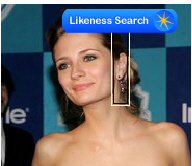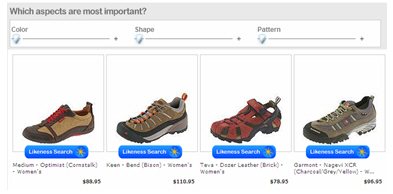 From ZDnet:
From ZDnet:Riya’s facial search service was one of the first darlings of the Web 2.0 world. The company garnered more than $15 million in venture capital to make facial and object search as easy as text search. It turned out that searching by facial similarity was a nice bit of computer science but not what turned users on.
Riya loaded 50 million faces from MySpace into its search engine and tested out the service with 100 users, mostly from MySpace. According to Riya CEO Munjal Shah, the testers didn’t find the facial search very useful, but visual similarity shopping for items such as shoes and jewelry was a hit. Today, Riya is launching an alpha version of Like.com, a new visual search shopping engine based on its visual recognition technology. Click on a photo of an item and Like.com compares the shape, color, and texture to other items in the database and displays the most similar results from merchants such as Amazon, eLUXURY, ICE.com, Lands’ End, ShoeBuy, and Zappos.
"We see a gap. There is little innovation from Google, Yahoo and other in image search,” Shah said. "Thirty billion items are sold on line with no great cross site search tool." As a result of the opportunity, Riya is not putting a lot of effort into its face recognition service, which has over 10 million uploads since it launched in March, Shah said.
Like.com is starting out by indexing images from jewelry, handbag, shoe and watch merchants, and will add clothing soon, Shah said. Jewelry, handbags and clothing are about a $15 billion business online. The target audience is women from 20 to 30. Furniture and home and garden (such as search for flowers) are being considered as additional categories.
Like.com offers several search capabilities, including the ability to search by image instead of text; finds items that have specific features, such as a watch bezel; find color variants of the item via a color picker; find clothing, shoes and accessories similar to those worn by your celebrities (Like.com includes 100,000 celebrity images); and in the near future the ability to upload photos. Like.com will also have a browser extension to initiate likeness searches from any site as well as pages to save searches and a recommendation engine. After launch Like.com will also have a cross-matching feature. "If you have a hat and want shirt to with it, you drag a slider and search on new category," Shah said.
 For example, users searching for a particular watch style can draw a box over dials on a watch face. If it has three dials, Like will return results with three dials. If the color of the band is chosen as a search criteria, Like will find all watches with the same color band or in slightly different shade. Users can interactively filter the results to find the the product that they desire. A slider can filter by shape, color and pattern for any of the products.
For example, users searching for a particular watch style can draw a box over dials on a watch face. If it has three dials, Like will return results with three dials. If the color of the band is chosen as a search criteria, Like will find all watches with the same color band or in slightly different shade. Users can interactively filter the results to find the the product that they desire. A slider can filter by shape, color and pattern for any of the products. The core technology is even more complex than face recognition technology, Shah said. Like.com crawls target merchant sites and retrieves the highest quality images. It takes about 20 seconds per image to preprocess, creating a visual signature and indexing the image.
The core technology is even more complex than face recognition technology, Shah said. Like.com crawls target merchant sites and retrieves the highest quality images. It takes about 20 seconds per image to preprocess, creating a visual signature and indexing the image. Search results are returned in under a second–the server farm consists of 250 quad-core servers, each loaded with 16 to 32 gigabytes of memory. Like.com converts every picture into a visual signature, a 10-kilobyte vector image consisting of about 5,000 numbers. The “likeness” algorithm determines the order of results based on shape, color and pattern.
“We are extracting and computing the visual signatures and pulling out pieces for comparison,” Shah said. “The results will never be worse than a text search. We index all the metadata and even normalized some of it.” Currently, Like.com only indexes the merchant sites.The soft goods vector images are more detailed than faces, which are encoded as 3-kilobyte vectors, and include about 40 elements, including shape densities, color histograms broken into quadrants and other properties, such as glossiness and sheen (analyzing color changes in the middle of objects).
The technology performs best when items are 2D or symmetrical, Shah explained. “Jewelry is the hardest because is has lot of artifacts. The way light bounces across the images sometimes get confused with holes in items, like rings. Other elements work on 3D items if they are symmetrical like a vase. It works with clothing like shirts but not well with skirts and bulky items—we can get the color and pattern but not shapes as easily, but the metadata is helpful with results.”
Like.com is open for business with an alpha version, and is adding about 30,000 items a day to the database. The first 10,000 Like.com shoppers will receive free shipping, up to $8, on their first purchase from any of the featured retailers.
Like.com gets paid via cost per click and cost per action. The company is looking to advertising as a revenue source, but is focused on building the audience first. "We are also having conversations with celebrity bloggers with images. We could create a new ad unit that goes into the picture. If someone clicks and buys, we share the revenue. However, our first goal get the search engine right and then add ad units for each category," Shah said.
Shah acquired the Like.com URL for about $100,000, which would be a bargain if the site is successful. From my test drive, just after the site launched. Riya seems to have figured out how to extract value from its visual search technology.










No comments:
Post a Comment